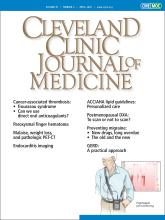A previously healthy 51-year-old woman reported recurrent episodes of blue discoloration of one or more fingers associated with pain and swelling and mainly affecting the intermediate phalanges of the fourth finger of each hand. During some episodes, the second and third fingers were also involved. Each time, the symptoms resolved spontaneously within 3 days.
She reported no other complaints and no recurrent trauma, spontaneous bleeding, palpitations, or discoloration of the fingers when exposed to cold. She was a nonsmoker.
Results of the physical examination were normal, including brachial and finger blood pressures, measured at the proximal phalanx of each finger, and Doppler studies of the brachial, radial, ulnar, and digital arteries. Other laboratory tests showed no signs of underlying inflammatory, hematologic, or coagulation disorder.
Based on the results of the evaluation, the patient’s condition was diagnosed as paroxysmal finger hematoma.
PAROXYSMAL FINGER HEMATOMA
Paroxysmal finger hematoma, also known as Achenbach syndrome, is a benign, self-limiting condition that predominantly affects middle-aged women.1 It is characterized by recurrent spontaneous subcutaneous bleeding in the fingers, typically on the palmar surface, mainly around the proximal interphalangeal joint creases. The cause is unknown, but local vascular fragility has been suggested.
Although relapses may frequently occur, no treatment is indicated, as the symptoms resolve spontaneously within a few days.
The diagnosis is based on the typical clinical presentation, as results of routine laboratory testing and Doppler studies of the arteries of the arm are usually normal.2 Therefore, it does not require further testing if the clinical presentation is typical and there are no clinical clues for an underlying disease such as Raynaud phenomenon, autoinflammatory disease, or thromboembolism.
The patient reported recurrent episodes of blue discoloration of the palmar surface of the fingers, associated with pain and swelling. The symptoms usually resolved within 3 days.
Unfortunately, the typical symptoms are often not recognized, resulting in unnecessary and potentially harmful diagnostic procedures such as tissue biopsy and catheter-based angiography. Hence, awareness of this benign, self-limiting syndrome is important.
- Copyright © 2020 The Cleveland Clinic Foundation. All Rights Reserved.







